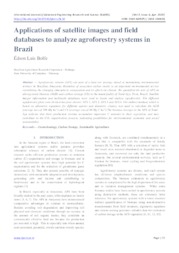Applications of satellite images and field databases to analyze agroforestry systems in Brazil.
Applications of satellite images and field databases to analyze agroforestry systems in Brazil.
Author(s): BOLFE, E. L.
Summary: Abstract - Agroforestry systems (AFS) are part of a land use strategy aimed at maintaining environmental services in Brazilian Amazonia. Retention of ecosystem carbon stocks is an important environmental service considering the changing atmospheric composition and its effects on climate. We quantified the role of AFS on aboveground biomass (AGB) and carbon storage (CS) in the municipality of Tomé-Açu, Pará, Brazil. Satellite images information and multiscale databases were used to locate and analyze agroforestry. The different agroforestry plots were divided into four classes: AFS 1, AFS 2, AFS 3 and AFS 4. The indirect method, which is based on allometric equations for different species and diametric classes, was used to calculate the AGB (average was of 106 Mg ha-1) and CS (average was of 48 Mg C ha-1).The biomass storages in the AFS of ToméAçu indicate that these production systems accumulate important C amounts in their vegetation, and may contribute to the CO2 sequestration process, indicating possibilities for environmental, economic and social sustainability
Publication year: 2020
Types of publication: Journal article
Observation
Some of Embrapa's publications are published as ePub files. To read them, use or download one of the following free software options to your computer or mobile device. Android: Google Play Books; IOS: iBooks; Windows and Linux: Calibre.
Access other publications
Access the Agricultural Research Database (BDPA) to consult Embrapa's full library collection and records.
Visit Embrapa Bookstore to purchase books and other publications sold by Embrapa.

